Welcome to Moda Fabrics!
Hours of Eye Candy: The Quilt Index
Hours of Eye Candy: The Quilt Index
If you love looking at and learning about quilts, the Quilt Index is for you.
 This c.1950 quilt was purchased from the estate of a member of the Blackfoot Native American tribe. [(Maker not recorded). c1950. From Michigan State University Museum, Michigan State University Museum Collection. Published in The Quilt Index, http://www.quiltindex.org/basicdisplay.php?kid=1E-3D-2791. Accessed: 05/29/2018]
This c.1950 quilt was purchased from the estate of a member of the Blackfoot Native American tribe. [(Maker not recorded). c1950. From Michigan State University Museum, Michigan State University Museum Collection. Published in The Quilt Index, http://www.quiltindex.org/basicdisplay.php?kid=1E-3D-2791. Accessed: 05/29/2018]
Founded in 2003, after nearly a decade of planning, the Quilt Index is a website that offers more than 90,000 searchable quilt records, ranging from Double Irish Chain quilts of mid-1800s to contemporary art quilts. While the Quilt Index is operated from Michigan State University (MSU), its database contains quilts from sources that include the American Folk Art Museum, the DAR Museum, the International Quilt Study Center and Museum, the Women of Color Quilters Network and more, plus numerous state quilt documentation projects and private collections. That adds up to a lot of quilts with a wide range of materials, themes, and back stories.
 McMaster, Annette. A long walk to freedom: A tribute to the life of Nelson Mandela. January - May 2014. From Michigan State University Museum, Michigan State University Museum Collection. Published in The Quilt Index, http://www.quiltindex.org/basicdisplay.php?kid=1E-3D-28FD. Accessed: 05/29/2018
McMaster, Annette. A long walk to freedom: A tribute to the life of Nelson Mandela. January - May 2014. From Michigan State University Museum, Michigan State University Museum Collection. Published in The Quilt Index, http://www.quiltindex.org/basicdisplay.php?kid=1E-3D-28FD. Accessed: 05/29/2018
It’s those back stories that make the site more than eye candy. Take for example, the story of Susan McCord (1829-1909), described as “an ordinary Indiana farmwife with an extraordinary genius for quilt making.” Susan and her husband Green farmed 80 acres and in addition she “kept house, brought up her children, sewed clothing for her family, knitted accessories, read her Bible through each year, participated in sewing bees, gardened, took care of the cows and chickens—and found time to make at least thirteen extraordinary bed quilts.” You can see examples of her quilts here. Click on each image to enlarge it and click again to close it.
 The maker of this quilt worked for the Atlas Underwear Company in Piqua, OH, in the early 1900s and made this quilt from a variety of labels. [Employee of the Atlas Underwear Company. Underwear Label Quilt. Early 1900s. From Michigan State University Museum, Michigan State University Museum Collection. Published in The Quilt Index, http://www.quiltindex.org/basicdisplay.php?kid=1E-3D-29A4. Accessed: 05/29/2018]
The maker of this quilt worked for the Atlas Underwear Company in Piqua, OH, in the early 1900s and made this quilt from a variety of labels. [Employee of the Atlas Underwear Company. Underwear Label Quilt. Early 1900s. From Michigan State University Museum, Michigan State University Museum Collection. Published in The Quilt Index, http://www.quiltindex.org/basicdisplay.php?kid=1E-3D-29A4. Accessed: 05/29/2018]
The director of the Quilt Index is Marsha McDowell, a curator and professor at MSU and the co-author of two books, Quilts and Human Rightsand Quilts and Health. “The first few years of the Quilt Index were geared toward preserving data from the quilt documentation projects and making it accessible,” she says. The site also enables viewers to select quilts to compare and contrast. Marsha’s enthusiastic about the Index’s future, which includes big changes coming this fall. Some of the features will include a new user interface, the ability to associate data—that is to look up quilts by their maker, pattern, or techniques—and the possibility to add authored comments so that knowledgable quilt historians can share their expertise and provide readers with additional information.
 A hand-pieced, hand-appliqued quilt by Addie Little, 1863. [Little, Addie. Album. 1863. From Michigan State University Museum, Michigan State University Museum Collection. Published in The Quilt Index, http://www.quiltindex.org/basicdisplay.php?kid=1E-3D-FB5. Accessed: 05/29/2018]
A hand-pieced, hand-appliqued quilt by Addie Little, 1863. [Little, Addie. Album. 1863. From Michigan State University Museum, Michigan State University Museum Collection. Published in The Quilt Index, http://www.quiltindex.org/basicdisplay.php?kid=1E-3D-FB5. Accessed: 05/29/2018]
Though Marsha doesn’t quilt herself, she’s endlessly fascinated with quilts, what compels people to make them, and what meaning they have for people. “In all these years of quilt studies I keep coming up with more ways to look at them anew,” she says. That’s why she’s excited about the changes coming to the Quilt Index, which she hopes will launch in October. “This will transform the Index into an exponentially better tool.” So, be sure to check out the changes in October, but don’t wait until then. Spend 15 minutes looking through the site—it will inevitably turn into 30 minutes and then an hour. But it’ll be time well spent. Inspiration awaits!
SaveSave

Comments